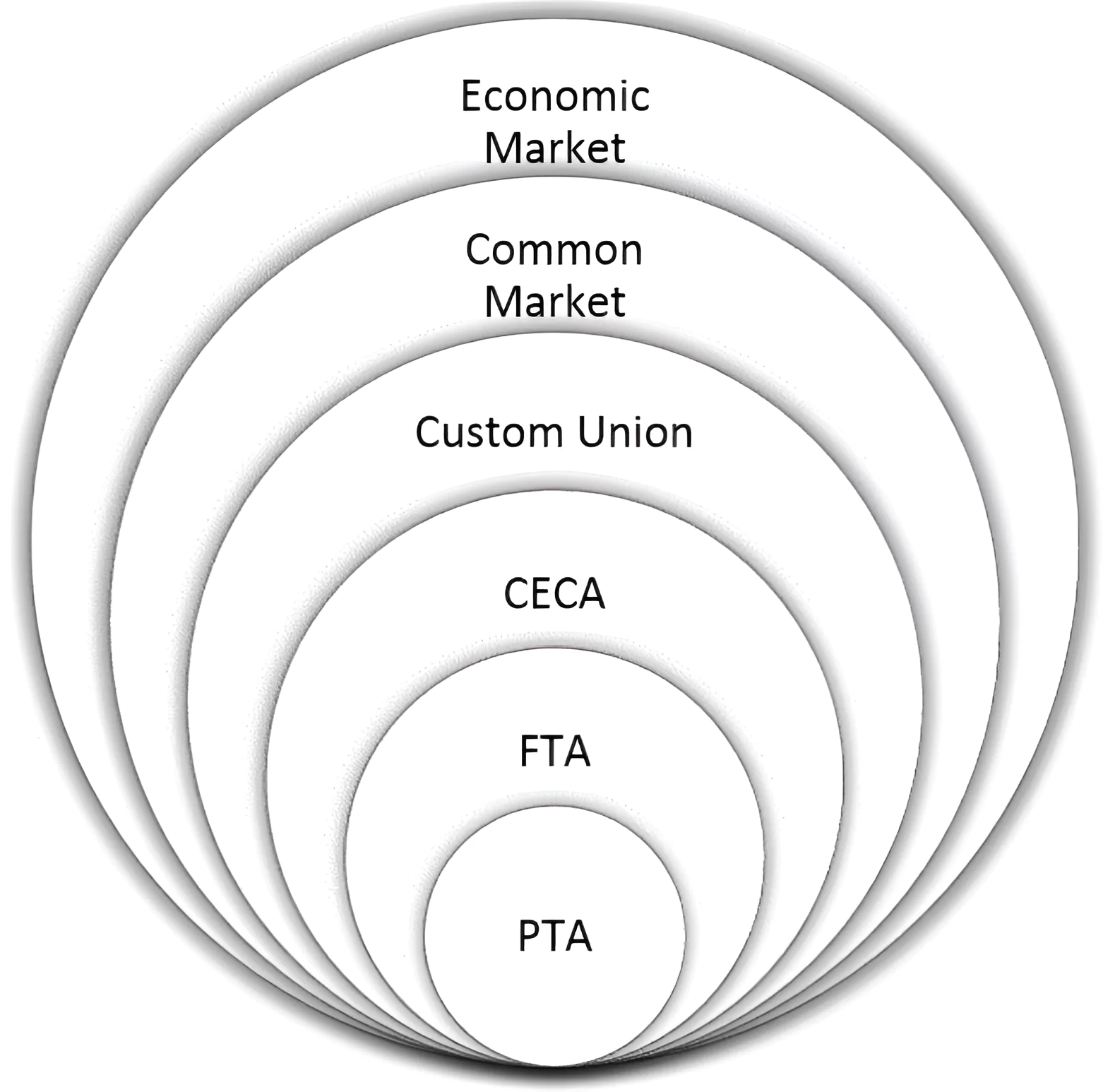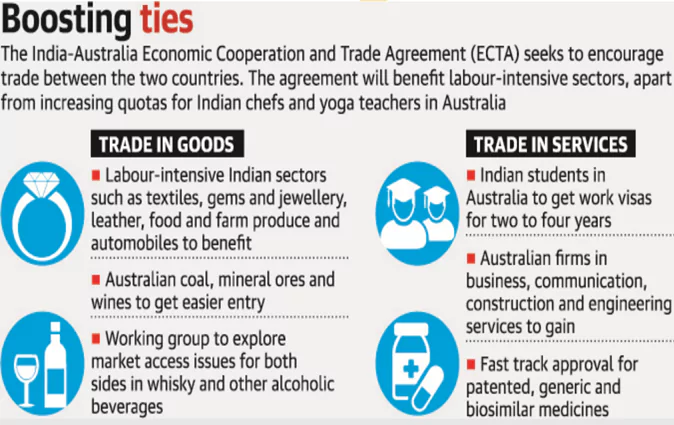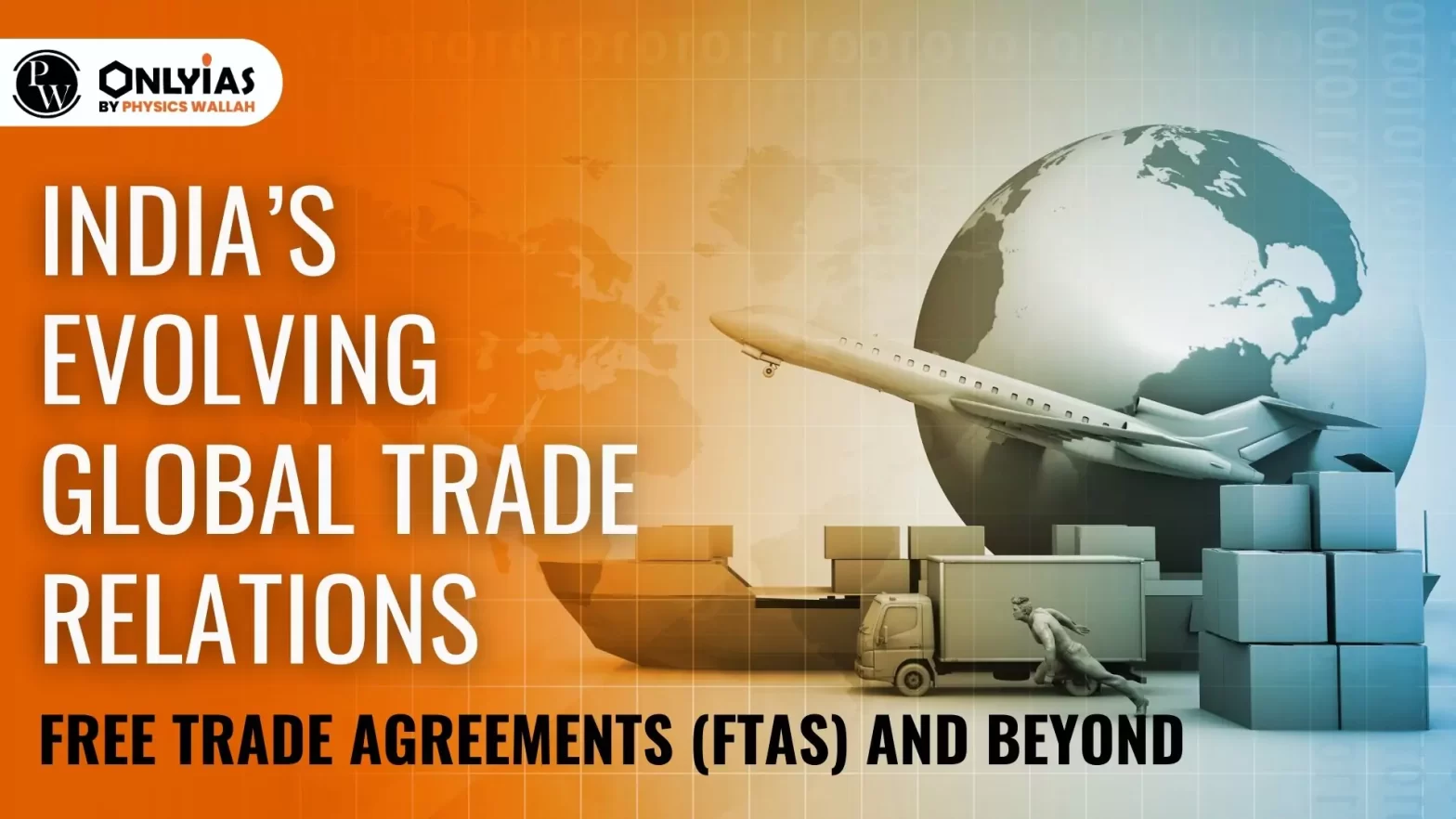Context:
- This article is based on the news “India’s Trade Trajectory: FTAs and Beyond” Which was published in the Live Mint. India has been refining its global trade strategy and emphasizing a fresh outlook on Free Trade Agreements (FTAs). It is currently negotiating a potentially landmark FTA with the UK.
Key Highlights on India’s Evolving Global Trade Relations
- India is on a journey to strengthen its trade relations with several nations with FTAs that promise mutual benefits.
- Agreements with ASEAN, Japan, and South Korea have significantly influenced India’s trade dynamics and have enriched its understanding of complex trade agreements.
- Experience: India negotiated key agreements in the recent past viz. UAE and Australia, reflecting the country’s adaptability in the evolving trade landscape.
- Importance of India-UK FTA Deal: It is critical in providing a window into India’s strategy for future Western negotiations and its handling of non-trade issues like environmental and labour standards.
- For example, the FTA will serve as a template for an agreement with the EU which is the second-largest destination for Indian exports (14.9% of the total) after the USA (18.1%) in 2021. It will further help in economic integration with Western and African nations to fuel export growth.
What are the Trade Agreements?
- Trade agreements are agreements between two or more countries for specific terms of trade, commerce, transit, or investment. They mostly involve mutually beneficial concessions.

- Depending on the terms and concessions agreed on by the participating bodies, there are several types of trade agreements- Free Trade Agreement, Preferential Trade Agreement, Comprehensive Economic Partnership Agreement, etc.
- Preferential Trade Agreement (PTA): Two or more partners give preferential right of entry to certain products by reducing duties on an agreed number of tariff lines.
-
- A positive list of the products on which the two partners have agreed to provide preferential access is maintained. For example, India signed a PTA with Afghanistan.
- India-MERCOSUR PTA: MERCOSUR is an economic grouping that comprises Argentina, Brazil, Paraguay, Uruguay, and Venezuela.
- Free Trade Agreement: Two or more countries agree to provide preferential trade terms, tariff concession, etc. to the partner country.
- A negative list of products and services is maintained by the negotiating countries on which the terms of FTA are not applicable. It is more comprehensive than PTA. India has negotiated FTA with many countries and regions viz.Sri Lanka, ASEAN, etc.
- Comprehensive Economic Partnership Agreement (CEPA): This partnership agreement is more comprehensive than an FTA. CEPA covers negotiation on the trade in services and investment, and it may even cover areas such as trade facilitation and customs cooperation, competition, and IPR. India has signed CEPAs with South Korea and Japan.
- Comprehensive Economic Cooperation Agreement (CECA): CECA generally covers negotiation on trade tariff and TQR rates only. It is not as comprehensive as CEPA. India has signed CECA with Malaysia.
What is the India-UK FTA Deal?
- Background:
- Initiation of Negotiations: Formal negotiations for a Broad-based Trade and Investment Agreement (BTIA) between India and the EU began in 2007.
- Rounds of Negotiations: Negotiations progressed through multiple rounds, but challenges arose over issues such as tariffs, intellectual property rights, and market access for goods and services.
- Stalled Progress: The negotiations faced a period of stalled progress, with both sides finding it challenging to resolve key issues.
- Post-Brexit Context: After the United Kingdom voted to leave the European Union in 2016, discussions regarding a potential trade agreement between India and the UK gained momentum.
- Official Launch of Negotiations and Continued Talks: Formal negotiations for the India-UK FTA were officially launched and negotiations continued as both sides engaged in multiple rounds of talks to discuss specific aspects of the agreement.
- Potential Benefits for India: India’s goals include the issue of priority visas to Indian professionals, positive signals toward a social security agreement, a specific pharma annex simplifying the pharma market access, and duty derogation for Basmati rice, etc.
- Benefits for UK: British exports to India such as cars, Scotch whisky, and wines, face considerable tariffs of 100-150%.
- Goods Sector: India’s negotiation strategy in the goods sector has historically been a key driver for countries to engage in FTA negotiations.
- Attention is given to strategic trade-offs concerning dairy products, wines and spirits, electrical and electronic items, and the automotive sector’s tariffs and regulations.
- Roadblock: UK negotiators are insisting on enhanced protection for the country’s geographical indication (GI) products originating from the agriculture sector.
- Key British GI items, such as Scotch whisky, Stilton cheese, and Cheddar cheese, are at the center of talks.
Know More about the INDIA-UK FTA deal here.
What is the significance of trade agreements for India?
- Economic Growth: Trade agreements play a pivotal role in trade facilitation by reducing barriers, streamlining customs procedures, and harmonizing regulations. This expanded market access can contribute to increased sales and economic growth.
- For example, in the period between 2017 and 2022, India’s exports to its FTA partners increased by 31%.
- Increases Foreign Direct Investment (FDI): Trade agreements often include provisions to protect and promote foreign investments. This can attract foreign companies to invest in India, leading to technology transfer, job creation, and increased productivity.
- Employment Opportunities: Export-oriented growth, can lead to the creation of jobs that indirectly contribute to skill development by promoting industries that require specialized knowledge.
- For example, Indian textile exports face tariffs as high as 10% in the UK, and a trade deal could put India on par with competition such as Bangladesh, and revive textile exports.
- Secure Supply Chains: Trade agreements can provide India with a more stable and diversified supply of critical raw materials and resources, and integrate India into global value chains, participating in different stages of production.
- The disruption of supply chains during the pandemic exposed the risks of over-dependence on China, and the need for a ‘China-plus one’ policy, India as a potential alternative has been looking at trade deals with the UK, Australia, and EU, etc.
- Consumer Welfare: Trade agreements can increase the variety of goods available to consumers and contribute to lower prices due to increased competition.
- For example, the potential India- UK FTA will increase competition from cheaper, imported brands which will provide imported items at a lower price.
What potential challenges does India face in relation to trade agreements?
- Complexity in Administration: Innovative tariff barriers such as Non-Tariff Barriers (NTB) and technical barriers to trade lead to increased administrative burdens and potential disruptions to operations.
- NTBs often come in the form of regulations, standards, testing, certification, or pre-shipment inspection that are aimed at protecting human, animal, or plant health and the environment.
- For example, vegetable and fruit exporters often face strict limits imposed by European economies on pesticides and other contaminants. In manufacturing too, Indian products face high rejection based on conformity assessments and technical requirements.
- Stringent Environmental Standards: Trade agreements that include environmental and social standards may lead to an increase in compliance costs affecting the competitiveness of certain sectors.
- For example, the European Union’s (EU) Carbon Border Adjustment Mechanism (CBAM) threatens substantial levies on products like steel and aluminum, thereby potentially impacting India’s exports to the EU.
- According to a consultation paper on the CBAM, the UK has shortlisted products such as cement, chemicals, glass, iron and steel, non-ferrous metals, non-metallic minerals, paper and pulp, refining, fertilizers, and power generation.
- Supply Chain Disruptions: Post-pandemic economic impact, global trade is becoming increasingly multifaceted. India faces these emerging challenges which can become major obstacles in fulfilling its ambitions of becoming an export-oriented manufacturing hub.
- Trade war between USA and China, COVID-19-induced lockdown, conflict in Ukraine, the rising cost of oil, global economic slowdown, and climate change-induced extreme weather events are leading to supply chain disruptions.
- Competitive Pressures: In some cases, trade agreements may expose Indian industries to intense global competition, particularly if partner countries have cost advantages or more advanced technologies.
-
- For instance, in the period between 2017 and 2022, India’s exports to its FTA partners increased by 31%, while its imports increased by 82%.
- South Korea and ASEAN’s manufacturing sectors outperform India’s in critical industries such as electronics, automobiles, leather, and textile products, among others.
- Agricultural Concerns: Trade agreements may lead to concerns among Indian farmers about increased competition from foreign agricultural products, potentially impacting local agriculture and livelihoods.
- India exited the Regional Comprehensive Economic Partnership (RCEP) to protect the interests of industries like agriculture and dairy.
| India’s Trade Agreements with Partner Countries/region |
Names of Trade Agreements |
| ASEAN |
India-ASEAN FTA |
| Japan |
India-Japan CEPA |
| South Korea |
India-South Korea CEPA |
| Mauritius |
India-Mauritius Comprehensive Economic Cooperation and Partnership Agreement (CECPA) |
| United Arab Emirates |
India-UAE CEPA |
| Australia |
India-Australia Economic Cooperation and Trade Agreement (Ind-Aus ECTA) |
What has India done to gain benefits from trade agreements?
- Investment in Manufacturing: The Production-Linked Incentive (PLI) scheme is strengthening India’s manufacturing sector by strategically targeting 14 key industries, including electronics, automobiles, pharmaceuticals, and more.
- Increasing Trade Facilitation: India has implemented various trade facilitation measures to combat high transaction costs and enhance the competitiveness of its exports.
- These measures and the digitalisation of business processes have streamlined cargo clearance, making it paperless and more efficient.
- Strong Infrastructure Push: Over the last nine years, India has invested around US$ 7 trillion in new projects as capital expenditures.
- There has been an increase in the construction of highways/roads with 10,457 kms of roads constructed in FY22 as compared to 6,061 kms in FY16.
- This is coupled with the capital expenditure on railways infrastructure and the aim of achieving 100% electrification by 2024.
- Policy Uptick Towards Increased Investments: Over the past few years, India has made considerable efforts to liberalising its foreign direct investment regime and increasing efficiencies in tax systems through the introduction of GST, faceless assessments, advance ruling authorities, etc.
- For instance, the introduction of a National Intellectual Property Rights (IPR) Policy in 2016 reduces complexities in incoming investments and trade.
Way Forward:
- Ensuring Policy Clarity: There is a need to clearly chart out policy plans for the next few years and implement them backward. India has come out with many tax and trade policies in the recent past to facilitate genuine investments and for taxpayers, long-term clarity may be missing.
- For example, the recently changed stance on import licensing for laptops is an indicator in this regard.
- Insight and Agility: There is a need for a clear strategy in response to global shifts, including recommendations for trade and associated regulations. There is a need to have clear insights into the role of India’s Missions to the World Trade Organisation (WTO), various countries, etc., and swift analysis and response is a must to determine India’s stance.
- For example, despite the CBAM draft being discussed in various forms since 2019, there is not enough done to educate exporters about CBAM effects.
- Pros and Cons Study: Have an unbiased study of India’s existing FTAs and drive pros and cons, which can help in upcoming negotiations.

-
- For example, the analysis could be on economic, supply changes, experiential, or geo-strategic lines, but should be clear and brief.
- New Delhi Effect: The ‘Brussels effect was coined due to the EU’s lead in international trade regulations over the past couple of decades.
- India needs to go for further policies in a manner that becomes a template for the less developed world which would be righteous considering India’s unique positioning as a leader of this bloc in the WTO and other organisations.
- Learning from Experience: As India navigates international trade, it must leverage its past FTA experiences, evaluate the present trade landscape, and prepare strategically for future challenges to fulfill its economic ambitions and contribute meaningfully to global trade.
- For example, India signed the CEPA with the United Arab Emirates and the ECTA with Australia, and India’s exports to both countries have shown a significant increase in a few months.
Conclusion:
In summary, India is adapting its trade strategy with evolving Free Trade Agreements, emphasizing lessons from past deals, and needs clear policies and agility to navigate global shifts for economic growth and meaningful contributions to international trade.
| Prelims Question (2018)
Consider the following countries:
1. Australia
2. Canada
3. China
4. India
5. Japan
6. USA
Which of the above are among the ‘free-trade partners’ of ASEAN?
(a) 1, 2, 4 and 5
(b) 3, 4, 5 and 6
(c) 1, 3, 4 and 5
(d) 2, 3, 4 and 6
Ans: (c) |
To get PDF version, Please click on "Print PDF" button.



